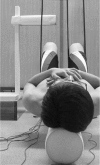Comparison of abdominal muscle activity during a single-legged hold in the hook-lying position on the floor and on a round foam roll
- PMID: 21944072
- PMCID: PMC3419152
- DOI: 10.4085/1062-6050-46.4.403
Comparison of abdominal muscle activity during a single-legged hold in the hook-lying position on the floor and on a round foam roll
Abstract
Context: To improve trunk stability or trunk muscle strength, many athletic trainers and physiotherapists use various types of unstable equipment for training. The round foam roll is one of those unstable pieces of equipment and may be useful for improving trunk stability.
Objective: To assess the effect of the supporting surface (floor versus round foam roll) on the activity of abdominal muscles during a single-legged hold exercise performed in the hook-lying position on the floor and on a round foam roll.
Design: Crossover study.
Setting: University research laboratory.
Patients or other participants: Nineteen healthy volunteers (11 men, 8 women) from a university population.
Intervention(s): The participants were instructed to perform a single-legged hold exercise while in the hook-lying position on the floor (stable surface) and on a round foam roll (unstable surface).
Main outcome measure(s): Surface electromyography (EMG) signals were recorded from the bilateral rectus abdominis, internal oblique, and external oblique muscles. Dependent variables were examined with a paired t test.
Results: The EMG activities in all abdominal muscles were greater during the single-legged hold exercise performed on the round foam roll than on the stable surface.
Conclusions: The single-legged hold exercise in the hooklying position on an unstable supporting surface induced greater abdominal muscle EMG amplitude than the same exercise performed on a stable supporting surface. These results suggest that performing the single-legged hold exercise while in the hook-lying position on a round foam roll is useful for activating the abdominal muscles.
Figures
References
-
- Liebenson C, Karpowicz AM, Brown SH, Howarth SJ, McGill SM. The active straight leg raise test and lumbar spine stability. PM R. 2009;1(6):530–535. - PubMed
-
- Cynn HS, Oh JS, Kwon OY, Yi CH. Effects of lumbar stabilization using a pressure biofeedback unit on muscle activity and lateral pelvic tilt during hip abduction in sidelying. Arch Phys Med Rehabil. 2006;87(11):1454–1458. - PubMed
-
- O'Sullivan PB, Phyty GD, Twomey LT, Allison GT. Evaluation of specific stabilizing exercise in the treatment of chronic low back pain with radiologic diagnosis of spondylolysis or spondylolisthesis. Spine (Phila Pa 1976). 1997;22(24):2959–2967. - PubMed
-
- Rydeard R, Leger A, Smith D. Pilates-based therapeutic exercise: effect on subjects with nonspecific chronic low back pain and functional disability: a randomized controlled trial. J Orthop Sports Phys Ther. 2006;36(7):472–484. - PubMed
-
- Suni J, Rinne M, Natri A, Statistisian MP, Parkkari J, Alaranta H. Control of the lumbar neutral zone decreases low back pain and improves self-evaluated work ability: a 12-month randomized controlled study. Spine (Phila Pa 1976). 2006;31(18):E611–E620. - PubMed
Publication types
MeSH terms
LinkOut - more resources
Full Text Sources




